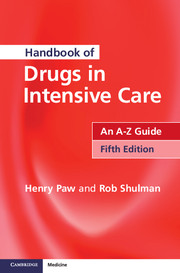Book contents
- Frontmatter
- Contents
- Introduction
- How to use this book
- Abbreviations
- Acknowledgements
- DRUGS: AN A–Z GUIDE
- SHORT NOTES
- Routes of administration
- Loading dose
- Drug metabolism
- Enzyme systems
- Drug excretion
- Drug tolerance
- Drug interactions
- Therapeutic drug monitoring
- Target range of concentration
- Pharmacology in the critically ill
- Cardiopulmonary resuscitation
- Drugs in advanced life support
- Management of acute major anaphylaxis
- Management of severe hyperkalaemia
- Management of malignant hyperthermia
- Sedation, analgesia and neuromuscular blockade
- A practical approach to sedation and analgesia
- Opioid Conversion table
- Management of status epilepticus
- Prevention of delirium tremens and alcohol withdrawal syndrome
- Prevention of Wernicke–Korsakoffsyndrome
- Anti-arrhythmic drugs
- Inotropes and vasopressors
- Bronchospasm
- Anti-ulcer drugs
- Immunonutrition in the ICU
- Corticosteroids
- Short synacthen test
- Bone marrow rescue following nitrous oxide
- Antioxidants
- Post-splenectomy prophylaxis
- Anti-microbial drugs
- Bacterial gram staining
- Antibiotics: sensitivities
- Renal replacement therapy
- Extracorporeal drug clearance: basic principles
- Drug doses in renal failure/renal replacement therapy
- Chemical pleurodesis of malignant pleural effusion
- APPENDICES
- DRUG INDEX
- IV COMPATIBILITY CHART
Sedation, analgesia and neuromuscular blockade
Published online by Cambridge University Press: 05 November 2014
- Frontmatter
- Contents
- Introduction
- How to use this book
- Abbreviations
- Acknowledgements
- DRUGS: AN A–Z GUIDE
- SHORT NOTES
- Routes of administration
- Loading dose
- Drug metabolism
- Enzyme systems
- Drug excretion
- Drug tolerance
- Drug interactions
- Therapeutic drug monitoring
- Target range of concentration
- Pharmacology in the critically ill
- Cardiopulmonary resuscitation
- Drugs in advanced life support
- Management of acute major anaphylaxis
- Management of severe hyperkalaemia
- Management of malignant hyperthermia
- Sedation, analgesia and neuromuscular blockade
- A practical approach to sedation and analgesia
- Opioid Conversion table
- Management of status epilepticus
- Prevention of delirium tremens and alcohol withdrawal syndrome
- Prevention of Wernicke–Korsakoffsyndrome
- Anti-arrhythmic drugs
- Inotropes and vasopressors
- Bronchospasm
- Anti-ulcer drugs
- Immunonutrition in the ICU
- Corticosteroids
- Short synacthen test
- Bone marrow rescue following nitrous oxide
- Antioxidants
- Post-splenectomy prophylaxis
- Anti-microbial drugs
- Bacterial gram staining
- Antibiotics: sensitivities
- Renal replacement therapy
- Extracorporeal drug clearance: basic principles
- Drug doses in renal failure/renal replacement therapy
- Chemical pleurodesis of malignant pleural effusion
- APPENDICES
- DRUG INDEX
- IV COMPATIBILITY CHART
Summary
The ideal level of sedation should leave a patient lightly asleep but easily roused. Opioids, in combination with a benzodiazepine or propofol, are currently the most frequently used agents for sedation, although benzodiazepines are associated with delirium and are increasingly avoided.
The most common indication for the therapeutic use of opioids is to provide analgesia. They are also able to elevate mood and suppress the cough reflex. This antitussive effect is a useful adjunct to their analgesic effects in patients who need to tolerate a tracheal tube.
Propofol has achieved widespread popularity for sedation. It is easily titrated to achieve the desired level of sedation and its effects end rapidly when the infusion is stopped, even after several days of use. Propofol is ideal for short periods of sedation on the ICU, and during weaning when longer-acting agents are being eliminated. Some clinicians recommend propofol for long-term sedation.
Currently, new sedative and analgesic drugs are designed to be shortacting. This means that they usually have to be given by continuous IV infusion. The increased cost of these drugs may be justifiable if they give better control and more predictable analgesia and sedation, and allow quicker weaning from ventilatory support.
- Type
- Chapter
- Information
- Handbook of Drugs in Intensive CareAn A-Z Guide, pp. 263 - 265Publisher: Cambridge University PressPrint publication year: 2014



